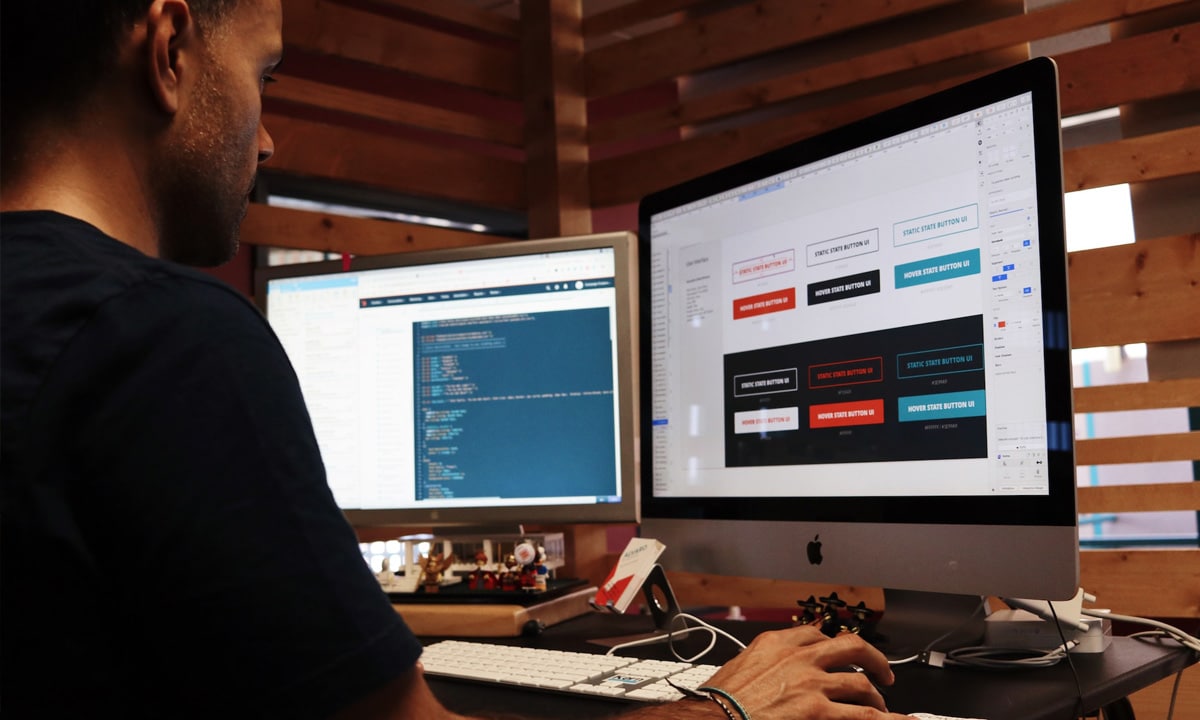Are you a small business owner who wants to create an excellent website for your business? You might have heard about web designers and developers, but what do they do? Understanding the difference between these roles is essential to choose the right people to help you.
At YEG Digital, we have over 15 years of experience working as Edmonton Web Designers and with WordPress experts. We have helped thousands of small and mid-sized businesses by designing and building their websites.
In this article, we will explain the difference between a web designer’s job and a web developer in a simple way. We will also talk about how new “page builders” tools have changed how these roles work together.
By the end of this article, you will have a better understanding of the web designer vs web developer roles and how they can help your business succeed online.
Web Designer vs Web Developer: An Overview

When creating a website, it’s essential to understand the distinct roles of website designers and web developers. While web designers focus on crafting the visual aspects and user experience, web developers ensure the site functions properly and performs well.
These two roles complement each other to create a seamless and engaging website experience for users. To help illustrate the differences, we’ve provided a chart below highlighting each role’s key responsibilities and skills.
| Aspect | Web Designer | Web Developer |
|---|---|---|
| Main Focus | Visuals and user experience | Technical functionality |
| Key Skills | Design, creativity, UX/UI | Coding, problem-solving |
| Tools & Languages | Adobe Photoshop, Illustrator | HTML, CSS, JavaScript |
| Role in a Project | Plan and design the website | Build and maintain the site |
| Collaboration with Others | Work with developers | Work with designers |
| Impact on a Website | Aesthetics, user engagement | Performance, functionality |
| Importance for Businesses | Attract and retain visitors | Ensure smooth site operation |
By understanding the unique roles of website designers and web developers, you can make informed decisions when building your website and ensure that the end result meets your expectations and goals.
Web Designer: Creating the Visuals

A web designer is like an artist for your website. They focus on making your site look good and easy to use. They choose colors and fonts and create images to make your website appealing to visitors. Website designers use tools like Adobe Photoshop and Illustrator to create their designs.
The main job of a web designer is to plan how your website will look. They design the layout, deciding where everything goes on each page. They also pick the colors and fonts that match your brand and make your website easy to read. Web designers create graphics and images that help tell your story and make your website more attractive.
Web Designer Roles and Responsibilities:
A good web designer and web developer can make a big difference for your website. They can help create a great user experience, meaning visitors will enjoy using your site and might even return for more. Web designers also help make your brand look consistent across all pages so your website looks professional. They also ensure your website works well on different devices, like phones and tablets, so that everyone can access it easily.
- Plan website layout
- Pick colors and fonts
- Create graphics and images
- Make the site work on different devices
- Improve user experience
- Keep a consistent brand look
In summary, web designers focus on making visual aspects of your website look great and easy to use. They play a crucial role in creating a successful website that attracts visitors and helps grow your business.
The Impact of Page Builders on Web Designers and Web Developers
In recent years, new “page builders” tools have changed how web designers and developers work together. Page builders are easy-to-use tools that allow you to create and edit websites without having to write any code. Some popular page builders include Wix, Squarespace, and Elementor.
With page builders, web designers can now create entire websites without the help of web back-end developers. They can drag and drop elements like text, images, and buttons onto the page, and the page builder handles the coding behind the scenes. This means that web designers can build websites more quickly and easily, saving time for front-end developers and money for small business owners.
Web developers are still important regarding more technical requirements and custom features. For example, if you need a special form, a unique animation, or a complex database for your website, a web developer can help with those tasks.
Pros of Page Builders
- Easy to use: No coding knowledge is required
- Faster website creation: Streamlines the design process
- Cost-effective: Reduces the need for developers
- Customizable: Wide range of templates and design options
- Accessible: Suitable for beginners and non-technical users
Cons of Page Builders
- Limited flexibility: May not support advanced features or custom solutions
- Potential performance issues: Can cause slower page loading times
- Generic designs: Templates might look similar across different websites
- Learning curve: Some builders have complex interfaces
- Dependency: Websites may rely on the builder’s platform, making it hard to switch
At YEG Digital, we have found that about 90% of the websites we build for clients don’t need the assistance of a web developer. This is because page builders have made it easier for website designers to create beautiful and functional websites without needing to write any code.
However, when a project requires more advanced features or custom solutions, our team of web developers is always ready to help.
Page builders have changed the roles of web designers, and web developers play back-end development, too, making it easier for designers to create websites without needing to write code. Web and back-end developers are still essential for more technical projects and custom features, ensuring your website is unique and meets all your business needs.
Choosing the Right Page Builder for Your Website
Choosing the right page builder can make all the difference when creating a stunning and functional website. With so many options available, finding the one that best suits your needs and skill level is essential.
So, let’s explore the top 10 page builders and briefly describe each, along with examples of who they’re best suited for.
1. Elementor
The Flexible WordPress Page Builder
Elementor is a powerful drag-and-drop page builder for WordPress, offering a wide range of customizable design elements and widgets. It’s user-friendly and suitable for both beginners and experienced website designers.
Example: Small business owners who want to create a custom WordPress site without the need for advanced coding skills.
2. Gutenberg
The WordPress Block Editor
Gutenberg is the default block editor for WordPress, which allows users to create content using pre-built blocks. It’s designed to make content creation accessible and user-friendly within the WordPress platform.
Example: Bloggers and content creators who prefer a simple, built-in editor for their WordPress site.
3. Wix
The All-in-One Website Builder
Wix is a popular website builder offering various templates and easy-to-use design tools. It’s perfect for small businesses and individuals wanting to create a website without coding knowledge.
Example: A beginner looking to create a visually appealing website with minimal technical expertise.
4. Squarespace
The Stylish Template-Based Builder
Squarespace is known for its sleek, professional templates and user-friendly user interface throughout. It’s ideal for creatives, photographers, and small businesses who want to showcase their work and create a strong online presence.
Example: A photographer who wants to create a stunning online portfolio to showcase their work.
5. Webflow
The Designer’s Web Design Tool
Webflow combines the power of a professional design tool with the flexibility of a web builder, allowing users to create custom, responsive websites without writing any code. It’s perfect for designers and agencies who want complete control over the creative aspects of their website’s design and functionality.
Example: A web designer who wants to create a custom site for a client without relying on traditional coding languages, coding, and programming languages methods.
6. Divi Builder
The Modular WordPress Theme Builder
Divi Builder, by Elegant Themes, is a versatile WordPress theme and page builder that offers a range of pre-built layouts and modules. It’s ideal for users who want to create custom WordPress sites with a modular, easy-to-edit approach to visual design.
Example: A marketing agency looking to quickly create custom WordPress sites functioning websites for multiple clients.
7. Beaver Builder
The User-Friendly WordPress Page Builder
Beaver Builder is a drag-and-drop page builder for WordPress that focuses on ease of use and flexibility. It’s perfect for users who want to create custom websites without the complexity of other builders.
Example: A freelancer who wants to build a WordPress site to showcase their services.
8. Thrive Architect
The Conversion-Focused WordPress Builder
Thrive Architect is a WordPress page builder designed to focus on conversion optimization. It offers tools and features that help users create high-converting landing pages and sales funnels.
Example: An online entrepreneur who wants to create a website that maximizes lead generation and sales.
9. Visual Composer
The Comprehensive WordPress Website Builder
Visual Composer is a feature-rich WordPress website builder that offers a variety of design elements and tools. It’s suitable for users who want a comprehensive solution for building custom WordPress sites.
Example: A web and graphic design agency looking for a flexible tool to create a wide range of WordPress sites for clients.
10. SiteOrigin Page Builder
The Lightweight WordPress Page Builder
SiteOrigin Page Builder is a lightweight, responsive WordPress builder that works with any theme. It’s perfect for users who want a simple, no-frills solution to create custom WordPress pages.
Example: A blogger who wants to customize their WordPress site without adding unnecessary bloat or complexity.
Web Developer: Bringing the Design to Life

A web developer is like a builder for your website. They take the designs made by web designers and turn them into functional websites. Web developers use programming languages called HTML, CSS, and JavaScript to make everything on your site function properly.
A web developer’s main job is to build your website’s structure. They make sure that all the parts of your site, like buttons and links, work the way they should. Web developers also make sure that the designs created by web designers look just as good on the actual website as they do in the plans.
Web Developer Roles and Responsibilities:
- Build the website’s structure
- Turn designs into a working site
- Make sure everything functions properly
- Speed up page loading
- Protect the site from threats
- Fix problems and keep the site updated
A good web developer is important for a successful website because they make sure your site is easy to use and works well. They help create a smooth experience for your visitors by making sure pages load quickly and everything runs smoothly. Web developers also work on keeping your website safe and stable, so you don’t have to worry about it crashing or being hacked.
In summary, web developers focus on making visual elements of your website function well and bringing the designs created by website designers to life. They play a key role as visual designer in creating a website that works well for your visitors and helps your business grow online.
When to Use a Web Developer
While page builders have made it easier for web designers to create beautiful websites, there are still instances when the expertise of a web developer is required. In cases where advanced features, customizations, or complex integrations are needed, a web developer can ensure your website meets your specific requirements.
Here are some examples of when you might need the help adequate knowledge of a web developer:
- API Integrations: If you need to connect your website to external services or applications, a web developer can help create seamless API integrations, ensuring your site communicates effectively with other platforms.
- Directories: When you want to create a custom directory or listing website that requires advanced search and filtering capabilities, a web developer can build the necessary functionality.
- Membership Websites: If you’re looking to create a membership site with different access levels, content restrictions, and subscription management, a web developer can help implement these features.
- Payment Processing: For e-commerce websites or online stores that require secure payment processing, a web developer can integrate payment gateways and ensure transactions are safe and smooth.
- Custom Plugins and Extensions: If you need specific functionality that isn’t available in existing plugins or extensions, a web developer can create custom solutions tailored to your needs.
- Advanced Forms and Interactive Elements: When your website requires complex forms, quizzes, or interactive elements, a web developer can build and implement these features for a better user experience.
- Performance Optimization: A web developer can help optimize your site for speed and performance, ensuring a faster, more enjoyable experience for your visitors.
In summary, while page builders have simplified the website creation process, there are still instances where the technical skills’ of a web developer are essential. By understanding when to engage a web developer, you can ensure your website’s framework is unique, functional, and tailored to meet your business needs.
Collaboration Between Designers and Developers
Effective collaboration between web designers and developers is crucial for the best possible outcome when designing websites. When both roles work together, they can create visually stunning, user-friendly, and technically sound websites. Here are some key points to consider for successful collaboration between website designers and developers:
- Clear Communication: Open and honest communication is vital for understanding each other’s perspectives, addressing challenges, and finding solutions. Regular meetings and updates help ensure everyone stays on the same page.
- Defined Roles and Responsibilities: Clearly outline the responsibilities of each role, ensuring that both the designer and developer understand their tasks and the project’s expectations.
- Establish a Shared Vision: Both parties should clearly understand the project’s goals and objectives, ensuring that the design and development processes align with the desired outcome.
- Use Collaborative Tools: Utilize tools that facilitate collaboration, such as project management software, version control systems, and design-sharing platforms. These tools make it easier to track progress, share feedback, and maintain consistency throughout the project.
- Mutual Respect: Recognize and value the expertise and contributions of designers and developers. Encourage a culture of mutual respect and appreciation, fostering a positive working environment.
- Flexibility and Adaptability: Be open to change and adapt as the project progresses. By maintaining flexibility, designers and developers can work together to overcome unexpected challenges and find creative solutions.
- Continuous Learning: Stay up-to-date with industry trends, design principles, and development practices. By continually learning and growing, designers and developers can contribute to a better end product.
When web designers and developers work together as a cohesive team, they can create websites that surpass expectations and deliver an exceptional user experience. By fostering these collaboration skills and maintaining open communication, you can ensure the success of the technical aspects of your website projects.
Choosing the Right Web Designer vs Web Developer
In the ever-evolving digital world, it’s crucial to understand the differences between web designers and website developers when embarking on a website project.
While most website designers focus on crafting the visual appearance and user experience, web developers ensure the functionality and performance of the site. Knowing when to engage each professional’s expertise can significantly impact your website’s success.
At YEG Digital, we offer a comprehensive web design and development solution catering to small and mid-sized businesses moving online. With over 15 years of experience working with WordPress, our team has designed and developed thousands of websites, each tailored to meet our client’s unique requirements.
Our skilled web and graphic designers are proficient in using page builders like Elementor, streamlining the design process and saving you time and money. For projects requiring advanced features or custom solutions, our seasoned website developers and visual designers are ready to tackle any challenge and deliver outstanding results.
Here are some key considerations when choosing between a freelance web designer and a web developer for your project:
- Visual Appeal and User Experience: If your primary concern is creating an aesthetically pleasing website focusing on user experience, a web designer is a right choice.
- Functionality and Performance: If your website requires complex features, customizations, or integrations, you’ll need the expertise of a web developer.
- Budget and Time Constraints: Using a page builder can save time and money, making it an ideal option for those with limited resources. However, for projects with specific requirements that cannot be achieved using a page builder, a web developer is necessary.
- Long-term Support and Maintenance: Consider the ongoing needs of your website, such as updates, bug fixes, and new feature implementation. Both web designers and developers can provide essential support and maintenance services to ensure your site continues to meet your objectives.
In conclusion, understanding the roles of web designers and developers is essential for creating a solid foundation for a successful website. By carefully considering your project’s needs and objectives, you can make an informed decision about which professional to engage. At YEG Digital, we’re here to help you navigate the process and bring your vision of web creator to life. Contact us today to learn more about our web design and development services and how we can elevate your online presence.